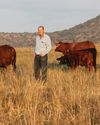Try GOLD - Free
Poor Sucking Reflex In Newborn Calves
Stockfarm
|October 2020
It all started with a conversation I had with a farmer who mentioned a friend who had trouble with newborn calves that were unable or unwilling to find the dam’s teats after birth. He referred to these newborns as ‘dummy calves’.

I contacted the farmer, who confirmed that he either had to force-feed the calves by putting the mother in the crush or feed them with a bottle. After about four days, he said, most calves seemed to start finding the dam’s teats on their own.
Apart from the inconvenience of having to feed these calves every few hours, there was the issue of not knowing how many calves might have been lost in the veld. He did some research on the cause and possible solutions and referred me to an article by Alex Ashwood, “Poor suckling reflex”, which appeared on the Australian Brahman Breeders’ Association’s website.
According to the article, studies in the United States (US) suggest that as many as 30% of suckling problems in newborn calves are due to a lack of an instinctive ability to suckle. If not attended to immediately, these calves will succumb (mortalities, the article stated, can be greater than 50%). This condition is often referred to as dummy or silly calf syndrome or, more correctly, poor sucking reflex (PSR) syndrome.
Although other factors may contribute to a calf having poor sucking ability, such as temperature and rainfall, neonatal infections, prolonged and difficult calving, abnormal milk production and rejection by the dam, PSR is very specific and has been known to occur in various breeds including the Angus, Hereford, Chianina, and Brahman.
This story is from the October 2020 edition of Stockfarm.
Subscribe to Magzter GOLD to access thousands of curated premium stories, and 10,000+ magazines and newspapers.
Already a subscriber? Sign In
MORE STORIES FROM Stockfarm

Stockfarm
Ecovite Drifos P12 and P6: Weather resistant phosphate supplements
Over 90% of South African soils are deficient in the mineral phosphorus. The country's warm, dry climate contributes to low levels of organic matter, which in turn limits phosphorus availability to animals.
4 mins
October 2025
Stockfarm
Tick resistance raises concerns
Ticks are the cause of significant annual economic losses, primarily because of the diseases they transmit. In South Africa, the blue tick species is the main culprit.
3 mins
October 2025
Stockfarm
The next generation herd health plan
<span class=
2 mins
October 2025

Stockfarm
When FMD hits: Protocols and practices
South Africa's cattle sector faces tremendous challenges regarding biosecurity and traceability. This year, the dairy industry was among the hardest hit by foot-and-mouth (FMD) disease outbreaks in most provinces in the country, especially the Eastern Cape.
10 mins
October 2025

Stockfarm
Back to basics: Success is built on simplicity and order
We live in an age of constant noise in which we are flooded daily with information and endless decisions.
7 mins
October 2025

Stockfarm
Grassland Society presents 60th congress
The 60th Congress of the Grassland Society of Southern Africa (GSSA) was recently held in Hilton, KwaZulu-Natal, drawing around 160 delegates from across Southern Africa.
3 mins
October 2025

Stockfarm
Livestock's water requirements in intensive and extensive production systems
The Earth's total water supply is estimated at around 1 386 million km³. However, only 2,5% of this comprises freshwater. Of that small fraction, approximately 68,7% is locked away in ice and snow formations in Antarctica, the Arctic, and mountainous regions.
4 mins
October 2025
Stockfarm
Breeding values level the playing field
The production of a dairy cow is influenced by factors such as age, calving season, lactation number and stage, pregnancy status, length of her previous intercalving period (ICP), nutrition, temperature, and management.
3 mins
October 2025

Stockfarm
Boost spring pastures with effective fertilisation
Applying the right nutrients to planted pastures that are tailored to the specific plant species and local environmental conditions, can significantly boost both yield and quality. However, given the high cost of fertilisers, they must be used efficiently to ensure pastures are optimally utilised by livestock. Renier Bothma, a soil scientist at Kynoch Fertilizers, explains that rainfall is a key factor in pasture production under dryland conditions. The more it rains, the greater the pasture growth and the higher the nutrient demand for maintaining optimal yield and quality.
3 mins
October 2025

Stockfarm
WHAT'S UP?
Theft burdens agricultural growth
6 mins
October 2025
Translate
Change font size

